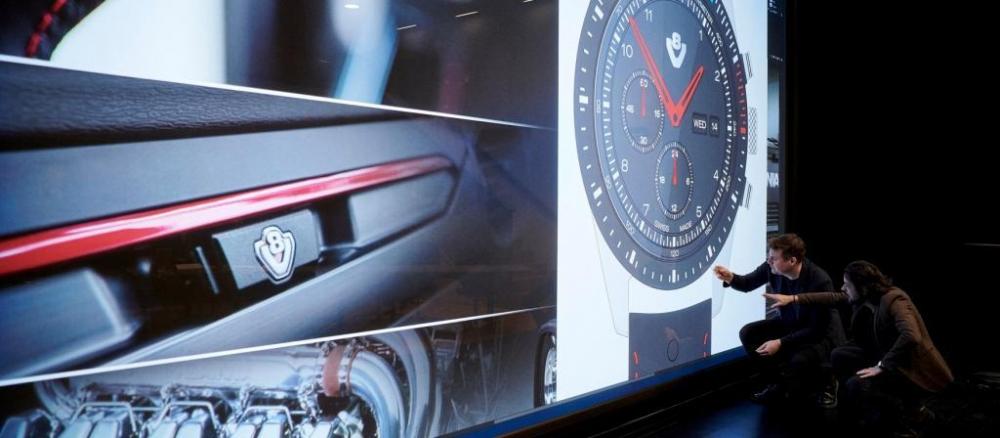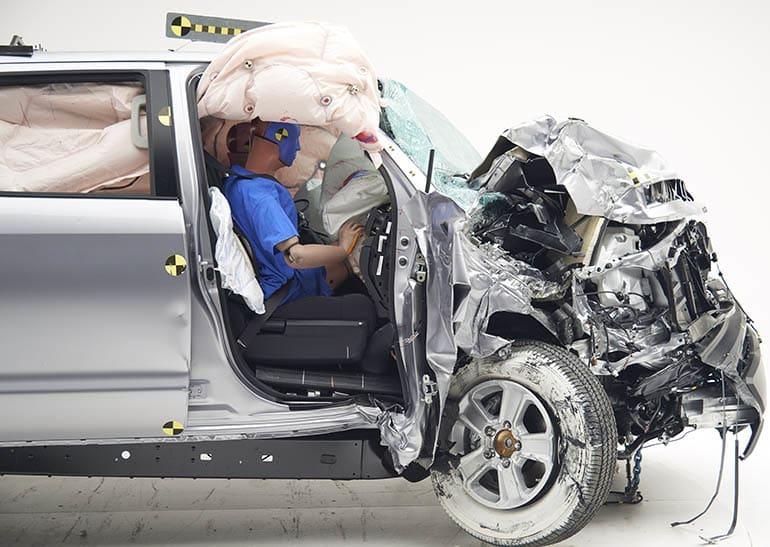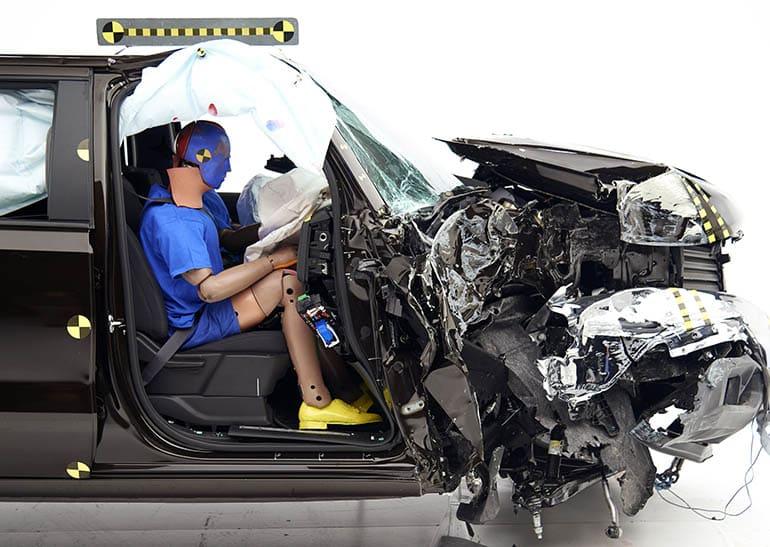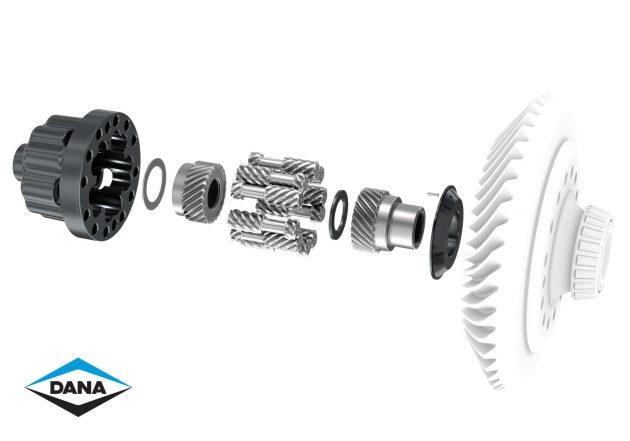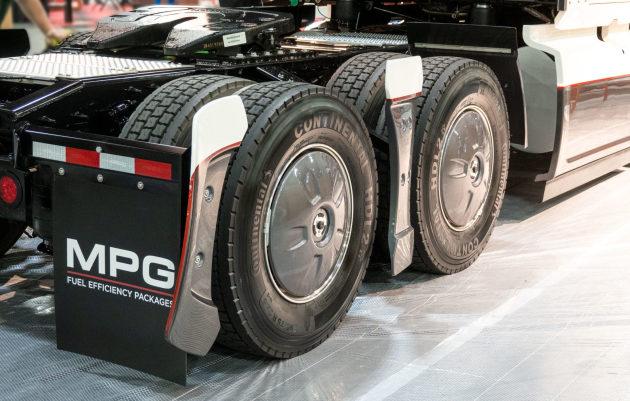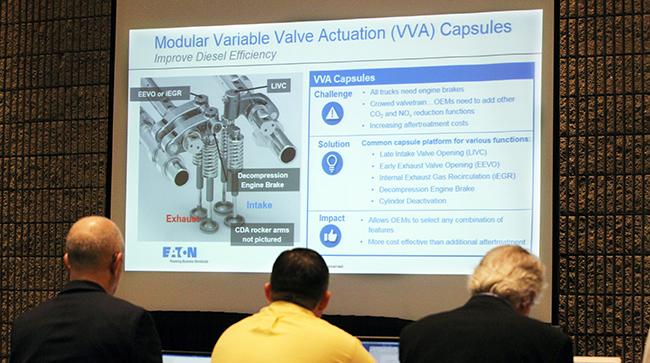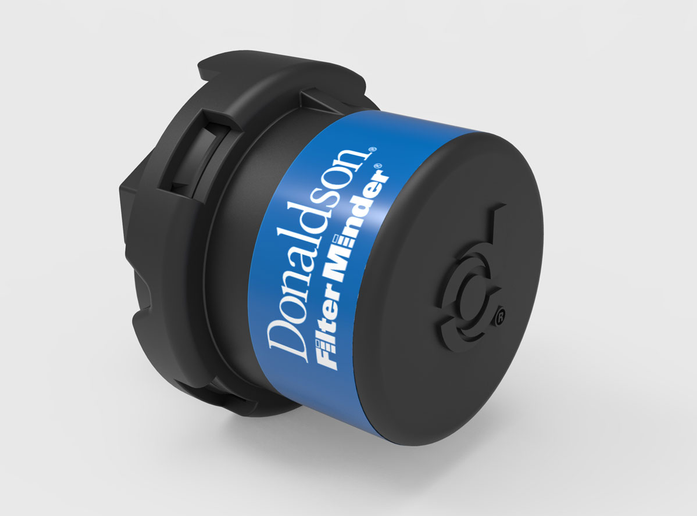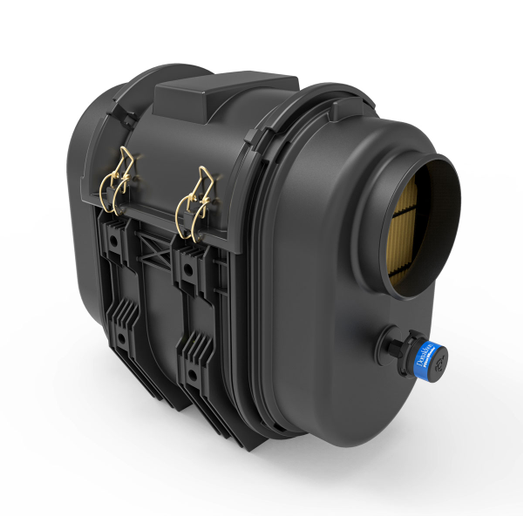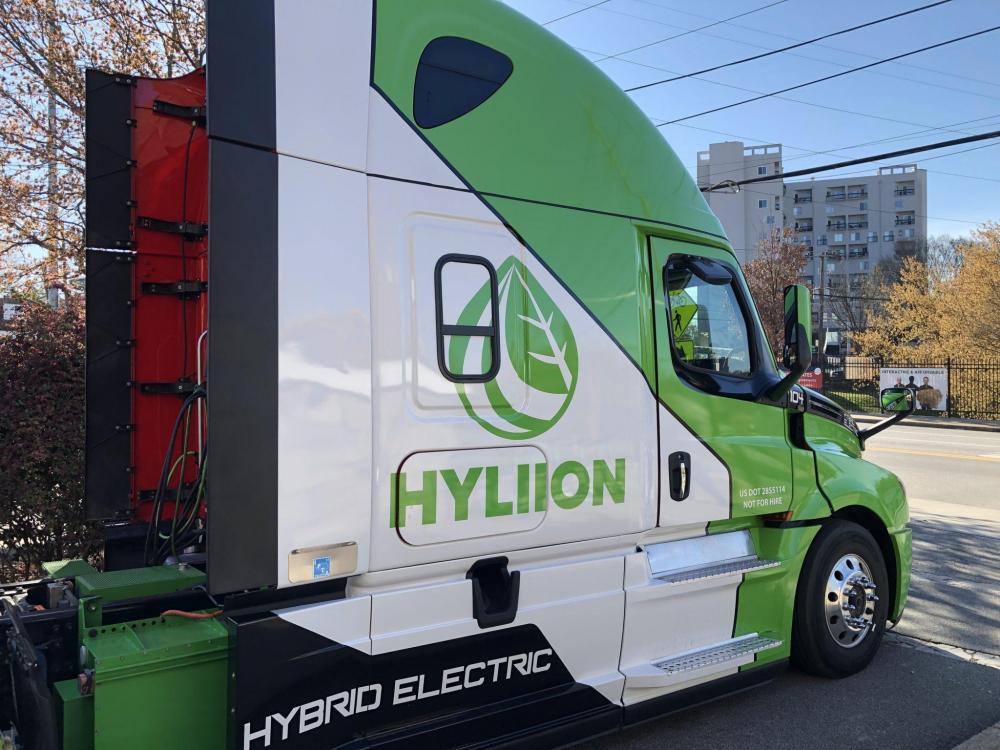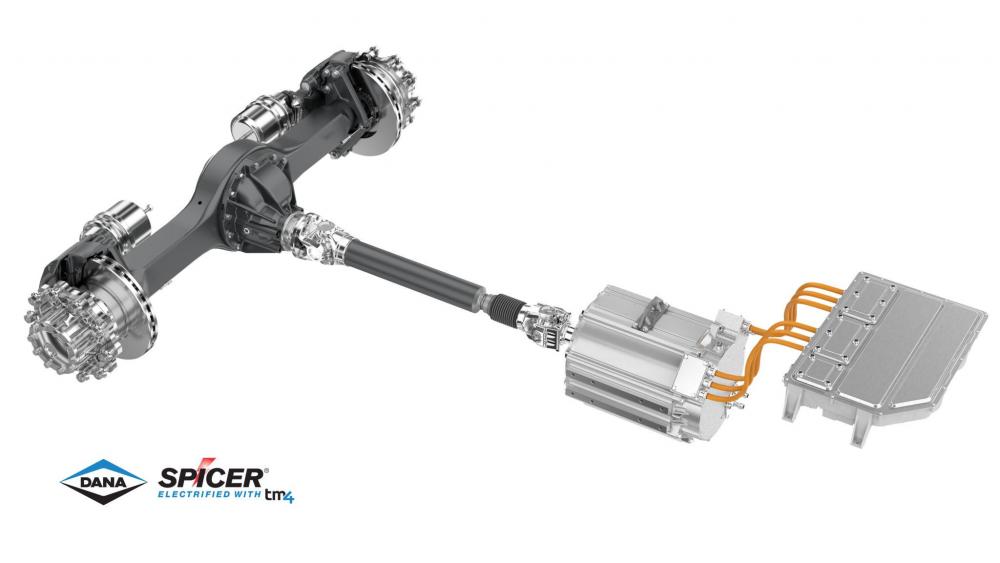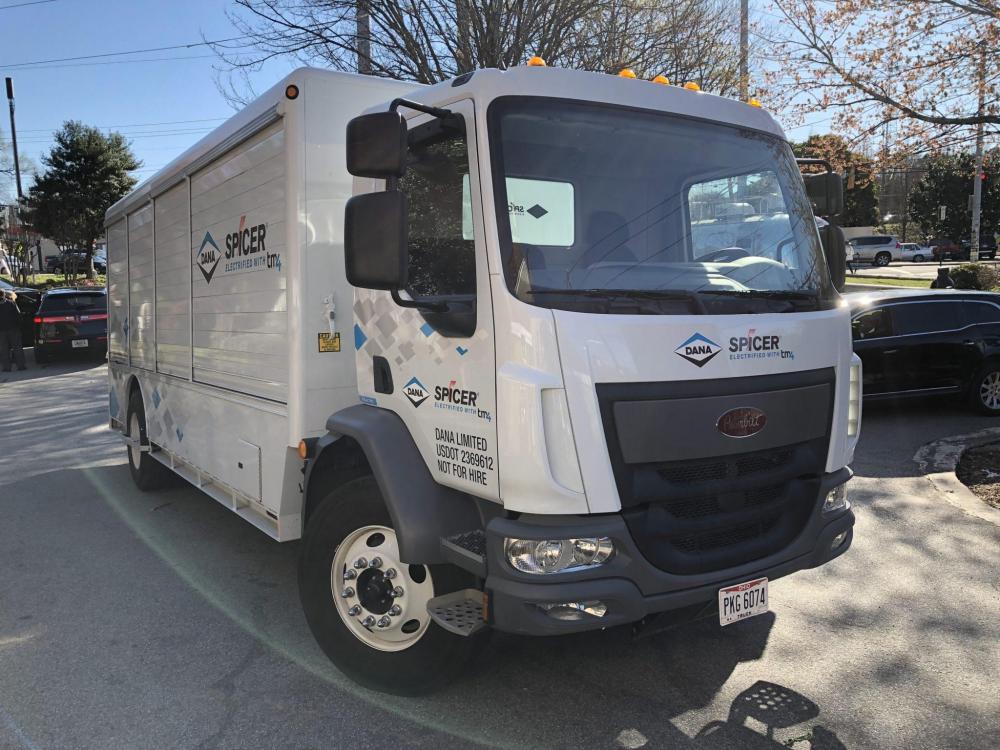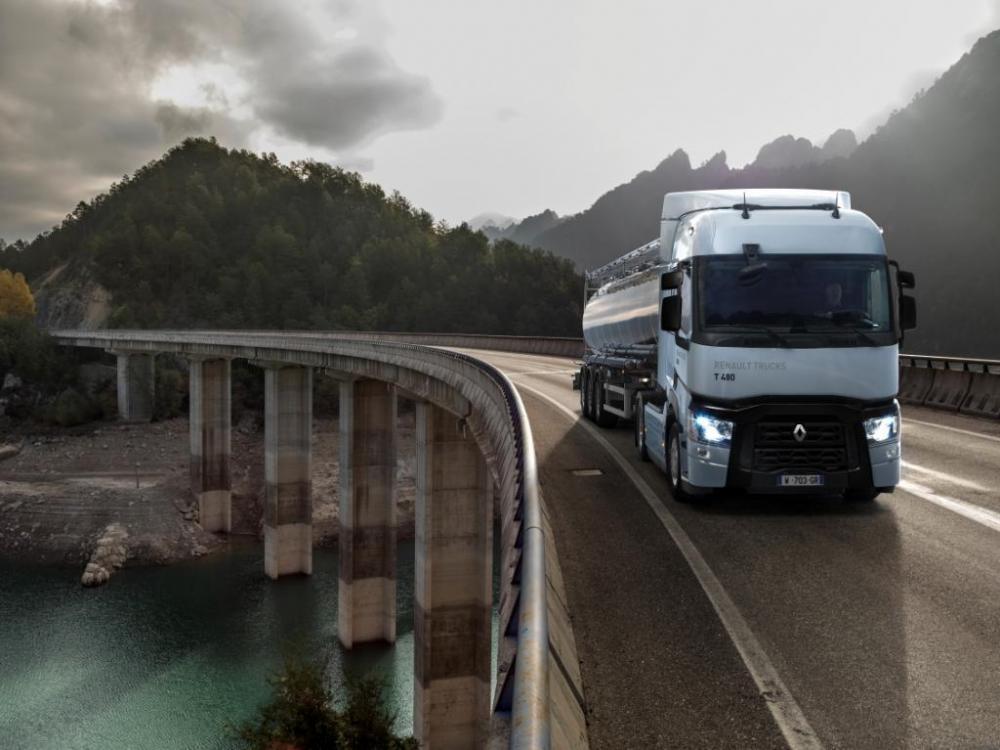
kscarbel2
Moderator-
Posts
18,876 -
Joined
-
Days Won
114
Content Type
Profiles
Forums
Gallery
Events
Blogs
BMT Wiki
Collections
Store
Everything posted by kscarbel2
-
Commercial Motor / March 20, 2019 .
-
Scania Group Press Release / March 19, 2019 Three new lines of specially-designed watches go on sale Scania has launched a special range of watches to mark the 50th anniversary of the V8 engine. The three different watches have been developed by Scania R&D designers, and those who wear them can expect to have a roaring time as the watches are inspired by details from the V8 truck. The watches were designed from scratch, making it possible for the design team to style them after features of the real trucks. “We could decide completely what details and design elements from the V8 trucks we wanted to highlight to get the proper V8 look and feel,” says Jesper Höglin, Product Manager at Branding Products. Close cooperation with R&D The new models have taken over a year to design and develop. During the conceptual phase, Antonio Cantos, Senior Graphic Designer and Fredrik Rudenstam, Team Leader Visual & Graphic Design at Scania’s R&D department sketched out and built models, applied details and produced a whole new design language. “When we developed the V8 merchandise products, we wanted to emphasise the heritage and what the V8 represents today: power and precision. The V8 is a source of great pride to Scania and to those who drive it,” says Rudenstam. He adds, “We have a refined exterior and powerful interior. Precision outside, power inside. Features that normally don’t fit together, but in the V8 they do. You get the power you need for a certain moment, combined with precision.” The watch cases are designed with elements and angles taken from the V8 truck and its engine. V8 Limited Edition The first model is the ‘V8 Limited Edition’, a chronographic (display and stopwatch) high-end watch. It comes in a limited edition of 500, each one numbered on the back. Its black leather band and red stitching evokes the look and feel of the V8 steering wheel. The model also has a timing feature and buttons on the side that are inspired by the V8 piston head, as well as a pattern with holes that is a nod to the V8 steering wheel. And the hands of the clock are the same as the speedometer needles. The Scania logo and V8 symbol adorn the watch face, while the Scania griffin is embossed on the rear. V8 Black Edition The second model ‘V8 Black Edition’ is sportier. It has the characteristic red colour from the V8 truck’s styling kit included on the strap, which is also inspired by the timing belt in the engine. The rough surface of the bezel (the grooved ring that holds the cover of the watch face in position) is meant to emphasise the tough heart of the truck. The watch face is adorned with the Scania logo and V8 symbol, while the case back is embossed with the Scania griffin. V8 Metal Edition On the third watch, ‘V8 Metal Edition’, small Vs have been added around the clock face, emulating the shape of the V8’s logo. It has a sleek and sturdy profile and a subtle brushed metal finish. The watch movement is solar powered and can run for more than four months on just one charge. Facts: The three new watches are available now. They are on sale at Scania dealers around the world and are also available via Scania’s web shop. https://www.scania.com/global/en/home/experience-scania/merchandise.html Only 500 of the chronograph model ‘V8 Limited Edition’ have been made, with each watch numbered on the back. Each model is solar-powered by a hidden panel beneath the dial that converts light into electrical energy. The watches can operate for more than two months on a full charge. They are water resistant to 100 metres. The watches have luminous hands and markers. .
-
F-150, Ram, Titan top IIHS passenger-side crash tests; GM pickups, Tundra among the worst Michael Martinez, Automotive News / March 21, 2018 The Ford F-150 is the only pickup to earn top ratings in passenger-side crash testing by the Insurance Institute for Highway Safety. The IIHS on Thursday said all four of General Motors' pickup nameplates earned only "marginal" ratings [pictured below], while the Toyota Tundra [pictured below] was the only one of 11 crew-cab pickups tested to get a "poor" rating. GM's pickups and the Tundra received "poor" ratings for how the vehicle's structure held up in the passenger-side small overlap test, which IIHS initiated in 2017. All 11 pickups tested earned "good" ratings for head, neck and chest injuries. The Tundra was the only one not to receive a "good" rating for hip and thigh injuries. The Ram 1500 and Nissan Titan joined the F-150 in receiving "good" ratings overall for passenger-side safety, though they landed one notch below the F-150 for structural integrity. The results contrast with top ratings for nine of the 11 pickups on driver-side testing conducted previously. The Honda Ridgeline, despite trailing the top performers with an "acceptable" overall passenger-side rating, is the only pickup to qualify for a 2019 Top Safety Pick award. That's because the Ridgeline is the only one to also get the required ratings of "good" for headlights and "superior" for front crash prevention. "We commend Ford, Nissan and Ram for providing state-of-the-art crash protection for both drivers and front passengers of their large pickup models," David Zuby, IIHS chief research officer, said in a statement. "As a group, however, the pickup class still has a lot of work to do." Small-overlap crashes account for about 25 percent of the serious driver injuries and deaths that occur in frontal impacts, IIHS says. The test, introduced in 2012, involves 25 percent of a vehicle's front end on the driver side striking a 5-foot-tall barrier at 40 mph. IIHS added a passenger-side small-overlap crash test in 2017. Vehicles are given "good," "acceptable," "marginal" or "poor" ratings. Many automakers initially struggled with the driver-side tests but have increasingly added features to improve their performance. Ford in 2015, for example, added steel horns -- known by most engineers as wheel blockers -- onto the frame of some F-150 versions to redirect the energy of the collision away from the passenger cabin. The automaker later spread the wheel blockers across all F-150s. For the redesigned 2019 Ram 1500, Fiat Chrysler Automobiles incorporated what it calls a "splayed" frame, spreading the leading elements of the frame outward on each side of the pickup -- and protecting the wheel in the process. IIHS said the Tundra's dummy received the most damage during testing, indicating a right lower leg injury would be likely in the event of a real-world crash. Right hip injuries also would be possible. Maximum intrusion into the Tundra's structure was 15 inches, vs. only 5 inches for the F-150. The dummy in the F-150, by comparison, showed no signs of potential injuries. The Tundra, along with the Nissan Frontier, are the only pickups to not earn a "good" rating in either driver-side or passenger-side tests. IIHS noted that they are the oldest in the group, with the Tundra's basic structure dating to the 2007 model year and the Frontier's to the 2005 model year. .
-
Matt Cole, Commercial Carrier Journal (CCJ) / March 20, 2019 Daimler Trucks North America is recalling more than 3,000 Freightliner Cascadia tractors over a potential issue with an optional steering wheel air bag, according to National Highway Traffic Safety Administration documents. The recall affects approximately 3,365 model year 2018-2020 Cascadia trucks equipped with the optional air bag. In these trucks, the air bag could deploy unexpectedly. DTNA says it will notify owners, and dealers will remove the air bag as an interim remedy, for free, while the company develops a remedy program. Owners of affected trucks can contact DTNA customer service at 1-800-547-0712 with recall number FL806. NHTSA’s recall number is 19V-066. NHTSA adds that this recall supersedes a recall issued in November over faulty air bags.
-
"It wasn't so much about avoiding tariffs," Hinrichs said, "it was about improving the business." These guys regularly lie through their teeth Bob.
-
Ford to build some EVs in Michigan, next Transit Connect in Mexico Michael Martinez, Automotive News / March 20, 2019 DETROIT -- Ford Motor Co. has changed its North American production plans for autonomous and electric vehicles, again. The automaker on Wednesday said its Flat Rock Assembly Plant near Detroit eventually will become a second location for production of battery-electric vehicles, in addition to a plant in Cuautitlan, Mexico. It is scrapping plans for an autonomous vehicle center at the Flat Rock site and instead will build those vehicles at another location in southeast Michigan. The $900 million Ford had planned to spend on AV production in Flat Rock through 2023 will instead be largely dedicated to EVs and the next-generation Mustang, officials said. The plant, which is scheduled to lose its second production shift this spring, eventually will get the shift back, along with 900 new jobs. Ford did not say when the jobs, which it had previously announced, would be added. As part of the moves, Ford said production of the next-generation Transit Connect van would shift to Mexico from Spain. Ford had been expected to start North American production of the Transit Connect, with Flat Rock among the locations believed to be under consideration. "It's a better plan for how we allocate capital in a more efficient way," Joe Hinrichs, Ford's president of global operations, told Automotive News. The automaker did not disclose a location, investment figure or jobs estimate for its autonomous vehicle center. In a statement, Ford said the site will upfit purpose-built, commercial-grade hybrid vehicles with self-driving technology and unique interiors. Production is slated to begin in 2021, with the vehicles being used commercially rather than sold to consumers. "As we ramp up AV production, this plan allows us to adjust our investment spending to accommodate the pace of growth of this exciting new technology," Hinrichs said. "This new plan combines our core strength in mass manufacturing with the agility and leanness we've shown with our modification centers for specialty manufacturing." Ford has shifted its EV and AV assembly plans several times since January 2017, when it canceled a $1.6 billion small-car plant under construction in Mexico shortly before President Donald Trump took office. At the time, Ford said it would make a big investment in Flat Rock to build autonomous vehicles and a long-range battery electric crossover. Later that year, it reversed the decision, saying it would focus on AVs in Flat Rock and move production of the battery-electric crossover to Mexico. The long-range battery electric crossover, which Ford says is inspired by the Mustang and due in 2020, will still be built in Mexico. Flat Rock will be dedicated to Ford's future EVs, which will sit on a new, dedicated battery-electric architecture. Ford's decision to build its next-generation Transit Connect in Mexico, after years of importing it from Spain and Turkey before that, allows the company to source more parts for the van from North American locations to meet requirements for the pending USMCA trade agreement. Ford is involved in a court battle with the government over allegations that it was unfairly skirting the so-called chicken tax -- a 25 percent tariff the U.S. has levied on light-truck imports since 1964 -- by bringing over Transit Connects that were built as passenger vehicles and then converting them to cargo vans stateside. The third-generation Transit Connect, which analysts expect to go on sale in 2021, will be made in Hermosillo, Mexico, where production of the Fusion and Lincoln MKZ is slated to end at an undisclosed time. "It wasn't so much about avoiding tariffs," Hinrichs said, "it was about improving the business."
-
Why don't you request one from your Mack brand distributor?
-
It was an available factory option. https://www.bigmacktrucks.com/topic/30186-macks-powered-by-other-engine-manufacturers/
-
Noose hanging at Ram plant adds to industry tensions Gabrielle Coppola, Bloomberg / March 19, 2019 Fiat Chrysler workers discovered a noose hanging in a Ram truck plant in Michigan late last month, prompting a second investigation into racism at a factory already simmering with tension. The company brought outside investigators into its Sterling Heights assembly plant to look into who hung the noose, commonly understood to be a threat of violence against African Americans, but hasn’t found the culprit. “If and when that person is identified, their relationship with the company will be terminated,” the automaker said. “This type of behavior will simply not be tolerated.” It’s the second internal investigation into racist harassment at the assembly plant north of Detroit since late 2017, according to people with knowledge of the events, and the latest in a series of racist incidents alleged at U.S. auto plants. At a UAW convention in Detroit last week, union members passed a set of resolutions that acknowledged “much more work to do” to secure protections against discrimination in the workplace. “A rise in recent years of incidents targeting people based on their race, gender, immigration status, or religious beliefs is impossible to ignore and requires an aggressive response,” the resolution stated. General Motors faces allegations of racial harassment at a plant in Toledo, Ohio, while Ford has settled claims at a Chicago factory. Fiat Chrysler workers at the Sterling Heights facility first reported ropes that looked like nooses hanging in the factory in late 2017, as the automaker started preparations for its new pickup, according to people familiar with the events, who asked not to be identified because they weren’t authorized to speak. The company investigated and determined there was no malicious or racist intent, but together with the UAW agreed that workers wouldn’t leave knotted ropes hanging to avoid any further offense or misunderstanding. Paint shop Workers reported finding another noose between 1 a.m. and 3:30 a.m. local time on Feb. 22 in the paint shop at the Sterling Heights assembly plant, commonly called SHAP. The next day, on a Facebook page for UAW Local 1700, which represents workers at the factory, an anonymous post was shared alluding to “several disturbing incidents” at the plant in the last few months, including one as recently as that week. “We must speak up and speak out when we are aware of heinous discriminatory acts being committed by co-workers,” the post reads. “Fear-mongering through race based attacks and antics should not and will NOT BE TOLERATED AT SHAP.” The people with knowledge of the noose incidents said tensions have risen at the Sterling Heights plant since headcount ballooned to more than 7,000 hourly workers, from about 3,000, after the company overhauled the factory to make pickups instead of Chrysler and Dodge sedans. A large portion of the new workers were transfers from a nearby Fiat Chrysler facility in Warren, Mich.. This influx has triggered conflicts over job placements and seniority, the people said. A separate noose incident took place at another Fiat Chrysler factory last year. A subcontractor fired one of its employees at the automaker’s Toledo Jeep plant in June for hanging one, a Fiat Chrysler spokeswoman said, confirming an earlier report by The Toledo Blade newspaper. Fiat Chrysler said it will continue to conduct training to “underscore the value of diversity and inclusion.”
-
GM to invest $2.7B in Brazil, maintain 15,000 jobs Reuters / March 19, 2019 SAO PAULO -- General Motors said on Tuesday it would invest 10 billion reais ($2.65 billion) in two of its Brazilian plants located in the state of Sao Paulo. The two plants are located in Sao Caetano do Sul and Sao Jose dos Campos and employ 15,000 people, jobs that will be maintained as part of the investment plan. Two months ago, GM's Brazil unit was in advanced talks with Sao Paulo state to receive tax incentives, the company told public officials and union representatives a few days after telling workers in a memo that it was losing money in the country. GM's top executives in South America attended the meeting along with union representatives and mayors of the two cities where the automaker's Sao Paolo state plants are based. Two officials representing the two cities told Reuters GM disclosed the tax incentive discussions at the meeting. The automaker, for several years, has been restructuring its operations in South America, where the automaker leads in market share. In February, GM CFO Dhivya Suryadevara said the company had reduced its break-even point by 40 percent since 2012. GM, she said, was working with dealers, suppliers, government officials and labor unions to “create a business plan that’s going to weather these economic circumstances better.” She noted foreign exchange rate – particularly for Brazilian and Argentinian currencies – as a continuing headwind. “What we’ve been doing is structuring the business such that even in more extreme levels of currency, we’re still able to break even and turn a profit,” she said. GM, according to Suryadevara, would share additional details of the company’s efforts in South America in the coming financial quarters.
-
Dana Press Release / March 18, 2019 Dana today announced the launch of its Spicer Trac-Lok limited-slip differential for Spicer S140 single drive axles, which will be available in June for medium-duty work truck applications. The differential provides improved traction during unexpected wheel-slip events and utilizes a reliable five-pinion design to serve Class 6 applications. The Spicer Trac-Lok provides improved traction capability without requiring switches, wires, sensors, air hoses or manual input from the driver. During a slip event, it automatically sends approximately three times more torque to the high-traction wheel-end. The Spicer Trac-Lok then returns to normal wheel-end differentiation as conditions change in order to deliver maximum vehicle handling. "The Spicer Trac-Lok differential for Class 6 applications utilizes a proven design from Dana products in the Class 5 and light-vehicle markets. Our team utilized an established Dana technology, making application-specific refinements and adaptations, to maximize benefits and increase productivity," said Mark Wallace, president of Dana Commercial Vehicle Driveline Technologies. "We are pleased to now offer a Dana-developed commercial-vehicle version of the enhanced differential for medium-duty applications that improves vehicle performance and uptime." In addition to providing automatic engagement and enhanced traction, the Trac-Lok device is lightweight and fully interchangeable with a Dana standard S140 axle differential. Trac-Lok will be available on Spicer S140 single drive axle models with gross axle weight ratings from 17,000 pounds up to 21,000 pounds. Simplifying installation and use, Trac-Lok does not require wiring, pneumatic connections, special lubricants, or additional friction modifiers. The Trac-Lok limited-slip differential is supported by Dana Aftermarket, which will offer Spicer Trac-Lok differential retrofit packages for all S140 drive axle models currently in service. .
-
Volvo Group Press Release / March 18, 2019 .
-
What is Mack thinking?
kscarbel2 replied to hicrop10's topic in Modern Mack Truck General Discussion
I'd argue the Paccar video is better, AND Paccar has not blocked North America-located people from viewing it. . -
Oshkosh Dealt a Blow in Pentagon Budget Lou Whiteman, The Motley Fool / March 16, 2019 A new military truck manufactured by Oshkosh is among the notable losers in the Pentagon's fiscal 2020 budget request as the Army rethinks its priorities and questions how many of the Humvee replacements it will need over the next half century. The Pentagon is requesting $1.6 billion to buy 4,090 Oshkosh-made Joint Light Tactical Vehicles (JLTVs) for the Army and Marine Corps as part of a broader request for $14.6 billion in ground systems. The JLTV request is down from the $1.928 billion allocated for 5,900 vehicles in fiscal 2019 and below the $1.9 billion the military was expected to spend on the vehicles in fiscal 2020. The Army had originally planned to spend at least $28 billion over the next 20 years to acquire more than 49,000 JLTVs, replacing about half of the service's Humvee fleet. Although the spending was to be spread out over decades, it is still significant for Oshkosh, which currently generates about $8 billion annually in revenue. Rethinking priorities Army officials admit that the reallocation of funding is likely not a one-time move. The Pentagon is in the process of shifting its attention away from fighting insurgencies in the Middle East and toward investment to prepare for a potential major power conflict with Russia or China. The Army is at the heart of the shift, with the service cancelling or scaling back nearly 100 programs over the next five years in order to free up $30 billion for higher-priority buys. The JLTV was designed specifically to address the shortcomings last-generation Humvees were found to have while operating in the desert, including the legacy vehicle's vulnerability to improvised explosive devices, but they are not central to a major-power war. Army Under Secretary Ryan McCarthy, during a press briefing on the budget request, noted that the Army currently has more than 100,000 vehicles in its fleet, saying there are limits on how many more are needed. "We're trying to hone in on the exact number of requirements of vehicles," McCarthy said. "That's why the buy will be truncated over time." Issues and design trade-offs The budget request comes less than a month after the JLTV was the subject of a Pentagon report that deemed it "not operationally suitable" due to a range of issues including "reliability, maintainability, training, manuals, crew situational awareness, and safety." The Pentagon's Director of Operational Test and Evaluation warned that the vehicle will likely require more maintenance than the Humvee, with a greater reliance on contractors to perform that maintenance due to its "poor manuals, and the challenges with troubleshooting the vehicle." The vehicle is also at a greater risk of being detected on the battlefield because of its larger size and greater noise signature, the report found. ----------------------------------------------------------------------- The Pentagon Just Slammed This Contractor's Flagship Vehicle Lou Whiteman, The Motley Fool / February 28, 2019 The Pentagon's Humvee replacement has been deemed "not operationally suitable" due to a wide range of deficiencies, a setback for the $30 billion program and a fresh challenge for vehicle manufacturer Oshkosh (NYSE:OSK). The first Oshkosh-made Joint Light Tactical Vehicles (JLTVs) were fielded at Fort Stewart in Georgia in mid-January, a major milestone for one of the Army's priority replacement programs. But according to an annual report prepared by the Pentagon's Director of Operational Test and Evaluation, those vehicles suffer from a range of issues in areas including "reliability, maintainability, training, manuals, crew situational awareness, and safety." The JLTV will likely require more maintenance than the Humvee, the audit warns, with a greater reliance on contractors to perform that maintenance due to its "poor manuals, and the challenges with troubleshooting the vehicle." The close-combat version is "not operationally effective for use in combat and tactical missions" at this time, the audit warns, because the missile reload process "is slow and difficult for crews," and the JLTV provides poor visibility for crews. The vehicle is also at a greater risk of being detected on the battlefield because of its larger size and greater noise signature, the report found. Trade-offs, teething, and training The report is a black eye for the JLTV, but some of the complaints are issues typical for a new program, and they can be addressed in later manufacturing batches. The vehicles have engine wiring issues and brake system faults that need to be redesigned, and in some cases, the doors would jam and prevent a quick exit from the vehicle. Other issues are tied to design choices made by the Pentagon. The JLTV from the beginning was meant to improve upon the Humvee's shaky record in the Middle East, where it was susceptible to ambushes and improvised explosive devices. The response was to create a larger vehicle with better body armor and more high-tech electronics. The armor and extra battery power for the electronics require a bigger, heavier vehicle with a more powerful, and louder, engine. The decreased visibility is another trade-off of loading the vehicle with more armor so it is better able to withstand an enemy attack. Much of the Pentagon's plan to address the identified shortcomings is classified, implying that the Army is willing to live with the issues and adjust tactics instead of demand wholesale changes to the design.
-
John G. Smith, Truck News / March 17, 2019 ATLANTA, Ga. – FlowBelow’s Tractor AeroKit system will be a factory-installed option on the International LT Series MPG Fuel Efficiency Package, available this spring. It also becomes a factory-installed option on any of the OEM’s new LT or RH Series trucks. International’s MPG Package, unveiled last October for the LT Series, includes FlowBelow wheel covers along with chassis skirts, a roof fairing, cab extenders, and an optional bumper valance. The next-generation MPG Fuel Efficiency Package adds predictive cruise control and the FlowBelow Tractor AeroKit. The FlowBelow products will be warranted by International Truck and be offered by International Truck dealers in the aftermarket. “With the addition of the FlowBelow Products on LT and RH Series trucks, we are providing fleets with even higher fuel efficiency while reducing total cost of ownership,” says Gordon Virginski, vice-president of OEM and dealer programs at FlowBelow Aero. “By adding our product they’ve increased fuel economy by just over 2%,” he adds, referring to the benefits of combined wheel covers and fairings. The company’s related trailer aerodynamics device was the first of its kind mounted to a trailer suspension, offering 1.37% fuel economy gains through combined wheel covers and a center bogie fairing. The second stage of the system, currently in beta testing, adds a fairing at the back end and essentially duplicates the system now available for tractors. FlowBelow boasts about 100,000 deployed units, saving about 20 million US gallons of fuel to date. .
-
Roger Gilroy, Transport Topics / March 17, 2019 ATLANTA — Upcoming regulations are expected to call for reducing simultaneously carbon dioxide and nitrogen-oxide emissions — prompting new engine components and processes, including hybrid-electric powertrains, an executive with Eaton Vehicle Group said. “We just came off a long, enforced march to reduce NOx and thought that was the end of it. But it’s not,” Mihai Dorobantu, director of technology planning and government affairs, said at American Trucking Associations’ Technology & Maintenance Council 2019 annual meeting here. Regulators in California and the U.S. Environmental Protection Agency, according to reports, are eyeing a 90% reduction in the limit on NOx compounds — down to 0.02 gram per brake horsepower-hour from the current ceiling of 0.2 gram, the limit since January 2010. NOx produces smog and ground level ozone. Reduced greenhouse gas emissions are on tap, too. Burning diesel fuel results in CO2 emissions. The GHG Phase 2 final rule, issued in June 2016, calls for lowering truck emissions of carbon dioxide and other greenhouse gases in 2021, 2024 and 2027, but it left in place the earlier limit on emissions of nitrogen oxide at 0.2 gram standard. The California Air Resources Board noted selective catalytic reduction systems, used to convert NOx using diesel exhaust fluid, are near the limits. “That means engine manufacturers likely will need to further reduce engine-out NOx, and/or provide additional heat to the SCR catalyst to maintain optimum temperature, to meet the new ultra-low emissions standards,” according to the agency. “But the physics and thermodynamics associated with those changes will result in worse fuel efficiency and increased GHG emissions.” To achieve both reductions at the same time will require the deep integration of modular and smart components plus flexible solutions, Dorobantu said. Eaton is addressing engine air management with modular variable valve actuation to allow better control of combustion and better regulation of emissions. At the same time, Eaton’s electric TVS exhaust gas recirculation pump allows the turbocharger to operate more efficiently and better control EGR. It offers about a 5% improvement in fuel efficiency, according to the Dublin-based company. Its hydraulic lash adjuster is intended to ensure precise valve seating and optimize engine air flow and fuel management, Dorobantu said. Meanwhile, Eaton’s eMobility segment has three primary areas of focus for automotive and commercial vehicle customers — intelligent power electronics, power systems and advanced power distribution and circuit protection. These include 48-volt mild hybrid systems that drive the heating, ventilation and air conditioning system and replaces the alternator to charge the battery. Another means is electric vehicle transmissions, including two-speed and four-speed models to tailor the behavior of the motor for specific applications. UPS Inc. said it operates nearly 700 hybrid electric vehicles. UPS ranks No. 1 on the Transport Topics Top 100 list of the largest for-hire fleets in North America. UPS has pledged to obtain 25% of the electricity it consumes from renewable energy sources by 2025 and replace 40% of all ground fuel with sources other than conventional gasoline and diesel, an increase from 19.6% in 2016, according to the Atlanta-based company. Transportation accounts for 30% of energy use, and Class 8 longhaul trucks burn about 7% of the national energy production, most of it in the form of petroleum products. “That’s a very juicy target if you are a utility and you want to grow, because there is only so much electricity you can provide in homes,” Dorobantu said. “A big needle mover would be to attack, and replace, the diesel market.” As for hydrogen-electric trucks — the industry is far from hydrogen infrastructure and distribution network. But the related technology in the truck — fuel cells and electric motors — exist today, he said. “But where do you get the hydrogen from?” Dorobantu said. “That’s the thing that is going to take a decade or more.” .
-
Jim Park, Heavy Duty Trucking (HDT) / March 17, 2019 Donaldson is bringing connectivity to filtration service reminders. The company's new Filter Minder uses the vehicles’ own telematics system to upload performance data to the cloud, where predictive analytics inform fleet managers when individual trucks are approaching optimal filter life. Donaldson announced its new Filter Minder during a press conference held at the American Trucking Associations’ Technology & Maintenance Council 2019 Annual Meeting & Transportation Technology Exhibition in Atlanta March 17. Filter Minder is currently in fleet testing monitoring truck engine air filters, but Donaldson said its capabilities will soon be expanded to include fuel, lube and hydraulics filters. Because it integrates with existing fleet management technology, the Filter Minder monitoring system is simple to install and use, Donaldson said. Comparable devices are bulkier, require wired hardware installations, and may need a dedicated cellular network. "Filter service performed too early is inefficient, and service performed too late can damage equipment, cause unplanned downtime and raise operating costs," said Nate Zambon, director of the Donaldson Filter Minder product line. "Maintaining the filtration system at the optimal time best protects the engine and drives down total cost of ownership." With no upfront hardware costs, easy installation and a low monthly subscription fee, Filter Minder connected technology can produce a substantial return on investment by prompting filter changes based on filter condition, rather than on scheduled maintenance intervals, according to Donaldson. The system also helps ensure that the right filters are in inventory when maintenance is due. "It may sound strange hearing a filtration vendor saying don't buy a filter, but we see that as part of Filter Minder's value proposition," Zambon added. "If we can save the fleet money and help it avoid unplanned downtime, then we are delivering value." Filter Minder technology provides: Wireless, simple installation in just minutes per truck; No upfront hardware costs and low monthly subscriptions; Patented low-energy sensors that conserve power and extend battery life; Filtration insights for an entire fleet of trucks consolidated into a dashboard view; Clear insights and customized alerts by text, phone, email or dashboard. Once oil filter data collection is made available, fleets can expect data from Filter Minder to be very similar to what they will see from oil analysis they might be currently using, such as real-time oil condition monitoring, as well as wear metals, fuel and coolant dilution and TBN. "When we acquired the maker of Filter Minder technology in 2015, Donaldson had a vision of combining our global leadership in engine filtration and filtration monitoring to develop a new generation of solutions," said Al Hovda, general manager of Engine Air Systems at Donaldson. "Our Filter Minder connected technology is practical, compact and makes fleet management easier while improving the cost of owning and operating long-haul trucks." .
-
James Menzies, Truck News / March 18, 2019 Taking Hyliion hybrid-electric with e-axle, and Pete 220 with Dana turnkey electric system on the road ATLANTA, Ga. – A Class 8 electric hybrid Freightliner Cascadia with the Hyliion e-axle, and a fully-electric Peterbilt 220 with Dana’s electric drive system were made available to the truck press for quick test drives during the spring meetings of the Technology & Maintenance Council. The hybrid-electric new Cascadia is essentially a conventional 6×4 diesel, converted into a 6×2 diesel with an electric tag axle. Energy is captured during braking and while descending grades, which is then stored and discharged through the e-axle – powered by Dana motors – when the truck is accelerating or climbing hills. This provides fleets with over-the-road fuel savings of as much as 12%, depending on route and terrain. The second element of the fuel savings, according to Hyliion account manager Matt Gold, comes from the electric Bergstrom auxiliary power unit (APU), which is also powered by the electric motor. It allows fuel savings of 5-10%, depending on which type of APU it’s replacing. The e-axle provides up to 115 hp and 1,500 lb.-ft. of torque. An algorithm within the control unit determines the output based on grade and terrain. From behind the wheel the truck has the feel of a normal diesel-powered vehicle, but on uphill grades the extra torque provided by the electric motor give it the ability to pull away. Gold said the target fleets for this configuration are those who operate in hilly terrain and currently idle overnight or use a diesel-fired APU. Fleets operating on flat ground are not likely to get the full fuel economy benefit. Hyliion so far has 15 trucks with its hybrid system out on the road, all of them in the U.S. But there has been interest from north of the border, especially among fleets operating in the mountains who want the additional uphill power, and those running compressed natural gas (CNG) engines, which at a 12-liter displacement, are moderately underpowered in some situations. “We’ve had very high interest from the Canadian fleets,” said Gold. “I think the market up there is very green-conscious and there are lots of opportunities for incentives.” Hyliion has yet to deploy a system into the Canadian market, but that’s mainly because it’s still a small outfit, with about 50-60 employees, out of Austin, Texas. It got its start in Pittsburgh, Pa., but moved to Austin to take advantage of the tech talent available there. It recently got a big boost of confidence – and capital – from Dana, which on March 5 announced it was taking a sizeable equity position in the company. Dana can now offer customers a complete hybrid-electric vehicle system, while Hyliion benefits from access to Dana’s technology, including electric motors and traditional components. Gold said ongoing fleet evaluations have been positive, with drivers appreciating the additional torque and fleets seeing fuel savings anywhere from 5-15% on the road, and another 5-10% from the electric APU. Inside the cab, drivers can monitor the co-pilot tablet to see how they’re performing and how the system is working. A white leaf indicates when the system is inactive. It turns green when the electric axle is working, and blue when the system is capturing energy from braking or descending a grade. The driver is rated based on his or her ability to drive the vehicle in a fuel-efficient manner. “We’re trying to develop a more unbiased way for fleets to rate drivers, and the goal is to build a reward system that’s tied to it as well as develop a mobile app and develop a new way to have a driver community,” Gold explained. The key to maximizing the benefit of the electric-hybrid system is to deploy it in the right setting, Gold emphasized. “A big learning we’ve had over the last three years is the importance of being on good routes,” he said, adding most validation has been done in West Virginia and Pennsylvania. The Hyliion system is still in fleet testing, with commercial production in the not-too-distant future. A fully-electric Pete 220 Also available for a short drive on Atlanta streets was a Peterbilt Model 220 with a fully-electric powertrain supplied by Dana, and its majority-owned subsidiary TM4 out of Quebec. The truck was upfitted by Nordresa with an urban beverage hauler body. Spec’s included: a Spicer S130 single reduction medium-duty single drive axle; SPL 100 driveshaft; TM4 Sumo MD HV2600-6P electric motor; a C0200 inverter; and a 93 kWh battery. The electric motor and inverter were supplied by TM4. The powertrain boasts an incredible 2,036 lb.-ft. of torque, close to that put out by the Cummins ISX15 15-liter engine. The truck can start on a 23% grade and maintain a 20% grade at 20 mph. It boasts a top speed of 70 mph and has a range of about 100 miles between charges. Basically, the truck can do everything its diesel-powered counterpart could do. Harry Trost, senior manager, product planning with Dana, pointed out these aren’t proprietary parts. In fact, the motor and inverter are in more than 12,000 vehicles in China. “So, this is production-validated, not a prototype,” Trost said. There is also little in the way of compromise when it comes to payload. The diesel engine and transmission are removed, and the battery management system drops into its place. Trost said the vehicle weighed 14,500 lbs unladen, which offered pretty much weight parity vs a diesel. The truck was completely silent at start-up and the torque was abundant upon acceleration. I barely needed to touch the brake to stop, as the regenerative braking brought the vehicle to a standstill while feeding energy back into the batteries. .
-
What is Mack thinking?
kscarbel2 replied to hicrop10's topic in Modern Mack Truck General Discussion
. For many, Volvo has that video blocked from being played in the US ("This video is not available in your country"). Here is a workable link. . -
What is Mack thinking?
kscarbel2 replied to hicrop10's topic in Modern Mack Truck General Discussion
1. Too slow/late.....irreversible in-depth damage already done. 2. The North American Titan show was an amateur effort. 3. Why did Volvo abandon the Mack heavy haul segment in the first place? From the day they took over, they ignored the Super-Liner product. -
How a 50-year-old design came back to haunt Boeing with its troubled 737 Max jet Ralph Vartabedian, The Los Angeles Times / March 15, 2019 A set of stairs may have never caused so much trouble in an aircraft. First introduced in West Germany as a short-hop commuter jet in the early Cold War, the Boeing 737-100 had folding metal stairs attached to the fuselage that passengers climbed to board before airports had jetways. Ground crews hand-lifted heavy luggage into the cargo holds in those days, long before motorized belt loaders were widely available. That low-to-the-ground design was a plus in 1968, but it has proved to be a constraint that engineers modernizing the 737 have had to work around ever since. The compromises required to push forward a more fuel-efficient version of the plane — with larger engines and altered aerodynamics — led to the complex flight control software system that is now under investigation in two fatal crashes over the last five months. Boeing’s problems deepened Thursday, when the company announced it was stopping delivery of the aircraft after the Federal Aviation Administration’s decision Wednesday to ground the aircraft. “We continue to build 737 Max airplanes, while assessing how the situation, including potential capacity constraints, will impact our production system,” Boeing said in a statement. The crisis comes after 50 years of remarkable success in making the 737 a profitable workhorse. Today, the aerospace giant has a massive backlog of more than 4,700 orders for the jetliner and its sales account for nearly a third of Boeing’s profit. But the decision to continue modernizing the jet, rather than starting at some point with a clean design, resulted in engineering challenges that created unforeseen risks. “Boeing has to sit down and ask itself how long they can keep updating this airplane," said Douglas Moss, an instructor at USC's Viterbi Aviation Safety and Security Program, a former United Airlines captain, an attorney and a former Air Force test pilot. "We are getting to the point where legacy features are such a drag on the airplane that we have to go to a clean-sheet airplane." Few, if any, complex products designed in the 1960s are still manufactured today. The IBM 360 mainframe computer was put out to pasture decades ago. The Apollo spacecraft is revered history. The Buick Electra 225 is long gone. And Western Electric dial telephones are seen only in classic movies. Today’s 737 is a substantially different system from the original. Boeing strengthened its wings, developed new assembly technologies and put in modern cockpit electronics. The changes allowed the 737 to outlive both the Boeing 757 and 767, which were developed decades later and then retired. Over the years, the FAA has implemented new and tougher design requirements, but a derivative gets many of the designs grandfathered in, Moss said. “It is cheaper and easier to do a derivative than a new aircraft,” said Robert Ditchey, an engineer, aviation safety consultant and founder of America West Airlines, which purchased some of the early 737 models. “It is easier to certificate it.” But some aspects of the legacy 737 design are vintage headaches, such as the ground clearance designed to allow a staircase that’s now obsolete. “They wanted it close to the ground for boarding,” Ditchey said. Andrew Skow, founder of Tiger Century Aircraft, which develops cockpit safety systems, and a former Northrop Grumman chief engineer, said Boeing has had a good record modernizing the 737. But he said, “They may have pushed it too far.” To handle a longer fuselage and more passengers, Boeing added larger, more powerful engines, but that required it to reposition them to maintain ground clearance. As a result, the 737 can pitch up under certain circumstances. Software, known as the Maneuvering Characteristics Augmentation System, was added to counteract that tendency. It was that software that is believed to have been involved in a Lion Air crash in Indonesia in October. The software erroneously thought the aircraft was at risk of losing lift and stalling — because of a malfunctioning sensor — and ordered the stabilizer at the rear to put it into a series of sharp dives that ultimately caused the plane to crash into the Java Sea. What happened on the Ethiopian Airlines flight is less clear, but tracking data show that it also encountered sharp changes in its vertical velocity and at one point in its climb after takeoff lost 400 feet of altitude. The FAA grounded the jetliner Wednesday, saying that new satellite data showed the Ethiopian Airlines flight dynamics were “very close” to those of the Lion Air jet. Ethiopia sent “black box” recording devices recovered from the crashed jet to France for analysis, after refusing to hand them over to U.S. authorities. The U.S. National Transportation Safety Board still plans to send investigators to France to help its Bureau of Inquiry and Analysis for Civil Aviation Safety. Airline crashes seldom are caused by a single factor, and the two 737 accidents may yet involve poor maintenance, pilot errors and inadequate training. But it appears increasingly likely that Boeing’s software system and the company’s lack of recommendations for pilot training on it may have played an important role in the crashes. The entire need for the software system is fundamental to the jet’s history. The bottom of the 737’s engines are a minimum of 17 inches above the runway. By comparison, the Boeing 757 has a minimum clearance of 29 inches, according to Boeing specification books. The newer 787 Dreamliner has 28 inches or 29 inches, depending on the engine. The 737 originally was equipped with the Pratt & Whitney JT-8 series jets, which had an inner fan diameter of 49.2 inches. “They looked like cigars, long and skinny,” Moss said. By comparison, the LEAP-1b engines on the Max 8 have a diameter of 69 inches, nearly 20 inches more than the original. There wouldn’t be enough clearance without some kind of modification. In the 737-300, which came after the original planes sold in West Germany, Boeing came up with an unusual fix: It created a flat bottom on the nacelle (the shroud around the fan), creating what pilots came to call the "hamster pouch.” “They made it work,” said Ditchey, whose America West was one of the original customers of the 737-300. But the LEAP engines required an even bigger change. Boeing redesigned the pylons, the structure that holds the engine to the wing, extending them farther forward and higher up. It gave the needed 17 inches of clearance. The company also put in a higher nose landing gear. The change, however, affected the plane’s aerodynamics. Boeing discovered the new position of the engines increased the lift of the aircraft, creating a tendency for the nose to pitch up. The solution was MCAS, which ordered the stabilizer to push down the nose if the “angle of attack” — or angle that air flows over the wings — got too high. The MCAS depends on data from two sensors. But on the Lion Air flight, the MCAS relied on a sensor that was erroneously reporting a high angle of attack when the plane was nowhere near a stall. The pilots tried to counteract the nose-down movements by pulling back on the yoke. But even pulling with all their might they could not counteract the forces, according to data in a preliminary accident investigation report. Skow criticized Boeing’s MCAS system, saying it acted only on the basis of angle of attack. The Lion Air jet was traveling so fast that when MCAS ordered the stabilizer to pitch the nose down it was a violent reaction. The software should have factored in air speed, he said, which would have better calibrated the pilots’ reaction. Skow’s firm has developed a cockpit display system, known as Q-Alfa, which he says would have identified the failure of the angle of attack sensor and allowed the crew to abort the takeoff. “We believe we could have prevented the accident,” he said. If the results of the investigation do not undermine the fundamental design of the aircraft, then the 737 Max’s future may not be in peril, aviation experts said. It may turn out all that’s needed is a software fix or additional pilot training. The 737 has survived other crises. In a 1988 accident on a flight between Honolulu and Hilo, the entire top of the plane came off in an explosive decompression. A flight attendant was sucked out and 65 passengers and crew were injured. It was blamed on faulty lap joints in the aluminum skin of the fuselage, which Boeing re-engineered.
-
Daimler Press Release / March 13, 2019 The Sideguard Assist has been available since 2016 in the Mercedes-Benz Actros and minimises the probability of dangerous accidents on the co-driver's side when the vehicle turns to the right. It has now been revised and improved for the digital future of trucks. In the new Actros, Sideguard Assist uses the MirrorCam display to warn drivers visually when the system detects a moving or stationary object in the monitored zone on the co-driver's side of the truck. The system can thus warn drivers in good time on the monitor of cyclists or pedestrians they may not have seen. MirrorCam and Sideguard Assist work hand-in-hand – overloading the driver with information is thus avoided and all of the relevant warnings are located together in a single location. In line with the launch of the new Actros, Sideguard Assist can now additionally support the driver under certain conditions when turning to the left. .
-
Renault Trucks Press Release / March 15, 2019 Renault Trucks has ended 2018 with a total volume of 54,868 vehicles invoiced, up 10% on the previous year. In a buoyant European market, the French manufacturer has strengthened its positions and increased over 16-ton market share by 0.2 points. In 2018, Renault Trucks recorded its fourth consecutive year of sales growth. The manufacturer has announced a rise of 7.6% in MHDV, and 15% in LCV. Breakdown in invoicing per destination - Europe (excluding France): 26,830 units invoiced (+13.5%) - France: 23,581 units invoiced (+10.1%) - Rest of the world: 4,457 units invoiced (-8.8%) Significant growth in volume in Europe In a dynamic European market for vehicles over 6 tons (up 4.2%), deliveries of Renault Trucks vehicles are up 7.6%. This has led to a slight increase in the French manufacturer’s market share, up 0.1 point to 8.5%. In the over 16-ton segment, Renault Trucks’ market share in Europe is up 0.2 points, at 8.9%. For vehicles between 6 and 16 tons, market share is down 0.3 points (6.2%). Registrations are down 3.8% due to the stoppage of the Renault Trucks D cab 2m model. On a like-for-like basis however, penetration remains identical. Renault Trucks has strengthened its position as leader in its home market, with a 28.1% market share. International sales marked by an upturn in Africa Deliveries of Renault Trucks vehicles have fallen 8.8% internationally, with 4,457 trucks invoiced. This downturn can be explained by the introduction of import quotas in Algeria in 2018. The manufacturer is particularly active in Africa, where sales have grown 25% in 2018. In French-speaking Africa, Renault Trucks holds 20% of the premium range market (+1 point). In 2018, the constructor also recorded good performance in Turkey (+2.1 points with 5.8% of MS) and in the Middle East (+1.1 point with 6.4% MS). A record 23% increase of for Renault Trucks used trucks In 2018, Renault Trucks recorded a record increase in sales of used trucks, with 8,500 invoiced vehicles, up 23%. Used trucks service offers are also performing well, notably due to the Selection structure warranty, with a penetration rate of 18%, up 6 points. Used vehicles represent a strategic sector for Renault Trucks. In 2017, the manufacturer opened a “Used Trucks Factory” at its Bourg-en-Bresse plant to recondition its used vehicles. In 2018, 400 used trucks were reconditioned there to meet customer requirements (compared to 230 in 2017). The aim is for vehicles from the Used Trucks Factory to eventually represent 10% of total sales of used vehicles. After the T X-Road, Renault Trucks launched another model from its Used Trucks Factory in 2018, the T P-Road, a tractor converted into a rigid truck. After-sales: spare parts turnover up 5% Renault Trucks after-sales division has reported steady progress of 5% in its spare parts turnover and a healthy increase in the sales of its maintenance contracts. With 32,000 vehicles under contract, the penetration rate of maintenance contracts grew by 5 points in 2018 to reach 23.6% (29% if Clovis Location contracts are included). 60,000 vehicles now benefit from a Renault Trucks maintenance contract or extended warranty. It is of note that Renault Trucks offers transporters ideal protection for operating with complete peace of mind, since the constructor has extended its guarantee warranty on spare parts fitted by an approved Renault Trucks service centre to 2 years, without any mileage restrictions. Renault Trucks preparing for the future Fuel savings and reducing CO2 emissions have always been a core concern for Renault Trucks. The manufacturer is therefore investing fully in complying with the limits set by the EU as regards CO2 emissions. At the end of 2018, Renault Trucks announced the launch of the 2019 versions of the T, D and D Wide models, designed to reduce fuel consumption by up to 7% compared to previous versions. Renault Trucks is also continuing its research into improving the efficiency of diesel vehicles, with its Optifuel Lab 3 laboratory vehicle. The aim is to reduce fuel consumption by 13% for a full heavy vehicle unit by 2020. Last but not least, for an immediate improvement in air quality, Renault Trucks will be launching its D and D Wide Z.E electric trucks in 2019, manufactured in its Blainville-sur-Orne factory. The Renault Master Z.E., on the other hand, is already being distributed in the Renault Trucks network. .
-
Robin Rasper, Goteborgs-Posten / March 12, 2019 A strong increase in sales with good profitability - AB Volvo is now approaching SEK 400 billion in sales. And the fourth quarter also provided increased earnings and improved margins. The improved deal is now also visible in the Volvo CEO's wallet. Last year, Martin Lundstedt raised his basic salary to SEK 14.6 million, from SEK 13.1 million a year earlier, shows the company's annual report for 2018. The CEO also discards a short-term variable remuneration of SEK 12.5 million. That is 87.7 percent of the bonus-based salary. According to the long-term variable incentive program, he will also receive SEK 10 million, which will be reinvested in Volvo B shares, if the upcoming general meeting gives a thumbs up. In addition to basic salary and bonus programs, the truck manager also has other advantages, mainly in the form of car and housing benefits. These amounted to just over SEK 300,000 in 2018. All in all, AB Volvo's CEO received a remuneration of just over SEK 37 million last year, including the remuneration from the long-term bonus program. Martin Lundstedt is also covered by a number of pension plans, in addition to the collective agreement pension benefit. In total, the Volvo Manager's pension premiums amounted to SEK 6.1 million in 2018, according to the recent annual report. AB Volvo reported an adjusted operating profit of just under SEK 40.7 billion for the full year 2018. This meant that the margin increased from 8.8 to 10.4 percent. .
BigMackTrucks.com
BigMackTrucks.com is a support forum for antique, classic and modern Mack Trucks! The forum is owned and maintained by Watt's Truck Center, Inc. an independent, full service Mack dealer. The forums are not affiliated with Mack Trucks, Inc.
Our Vendors and Advertisers
Thank you for your support!


